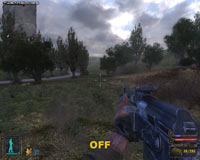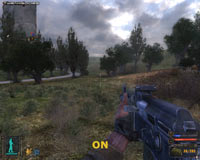STALKER: Shadow of Chernobyl Tweak Guide
[Page 6] In-Game Settings (Pt.2)
Sun Shadow: When enabled, the Sun is a dynamic light source (depending on your Renderer chosen), and as such all objects can cast shadows from their exposure to the sun. While this greatly enhances the realism and atmosphere of the game, it can also greatly reduce performance. If you wish to turn off the Sun as a dynamic light source, disable this option, and your FPS will improve noticeably.
Grass Shadow: If enabled, the grass in outdoor areas will have shadows of varying intensity. If disabled, all grass-related shadows are removed, which can improve performance. The image quality drop is not significant, so disable this option if you're struggling for FPS. Note that if Sun Shadows is disabled, Grass Shadows will also be disabled automatically.
Update: As of the 1.0004 patch it seems that Grass Shadows do not appear even when enabled. The cause is not yet clear. This issue should be resolved as of the most recent patch.
Lighting Distance: This slider controls the visibility distance of lighting sources in the game. Experimenting with this setting I found no real visual impact as the slider position was changed. However my FPS did improve from lowering this slider, so it can be a useful performance boost with no major drop in image quality.
NPC Flashlights: If this option is enabled, Non-Player Characters (NPCs - i.e. any computer-controlled characters) can use flashlights similar to the one you have. While this increases realism, in scenes with multiple flashlights and in particular with dynamic lighting enabled it also reduces FPS. If you find heavy combat scenes are becoming quite 'laggy', you may want to disable this option, but note that this also makes finding the enemy slightly harder at night or underground, since you can't track them or see them approach just by their torchlight.
Shadows Quality: This slider determines the appearance of shadows cast from dynamic lights in the game, with the higher the quality the lower your FPS. The difference between the lowest and highest setting on this slider is difficult to capture in a screenshot - in general the difference is not major, the most noticeable effect being that low quality shadows are blockier and slightly less distinct, and tend to shimmer more as they move. Note that you can further customize shadow quality by directly choosing shadow map resolution sizes with the -smap1536, -smap2048, -smap2560, -smap3072, and -smap4096 switches covered in the Advanced Tweaking section.
Vertical Sync: Video Synchronization (VSync) is the synchronization of your graphics card and monitors' abilities to redraw an image on the screen a number of times each second, measured in Hz. It is explained clearly on this page of my Gamer's Graphics & Display Settings Guide. When VSync is enabled your maximum FPS will be capped at your monitor's maximum refresh rate at your chosen resolution, and more importantly in some areas your FPS may drop by as much as 50% if the graphics card has to wait to display a whole frame. Thus enabling VSync can have a major negative performance impact, though you can also counter it by enabling Triple Buffering. However this setting appears broken, since STALKER seems to have VSync disabled regardless of what setting you choose here. While it is generally recommended that you keep VSync disabled, if you find the image 'tearing' which accompanies disabled VSync to be annoying, you can enable VSync in STALKER only by forcing VSync On in your graphics card's control panel - see the Nvidia Forceware Tweak Guide or the ATI Catalyst Tweak Guide for details.
Frequency 60Hz: If disabled, this option allows your Refresh Rate to exceed 60Hz. There should be no reason why you should enable this option, as most CRT monitors and some LCD monitors can exceed a 60Hz refresh rate which can both help to improve FPS if VSync is enabled, and reduce eye strain on CRT monitors.
Sound
SFX, Music Volume: These sliders control the volume level of the Special Effects (SFX), and any music in game, such as that played in the main menu. Setting these sliders to the far left does not turn remove music or sound effects, so it has no impact on performance. See the Advanced Tweaking section if you wish to actually disable the loading of all sounds, e.g. to troubleshoot a sound problem.
EAX: You can enable Environmental Audio (EAX) on sound cards which support this functionality - primarily Creative SoundBlaster/Audigy/X-Fi cards. When enabled, sound effects will become more realistic in 3D space, but it may also reduce performance slightly and cause audio glitches on some systems.
If you are having audio problems, first make sure you're running the latest audio driver for your sound solution. Then you may want to try switching the audio renderer, either to see if performance and/or functionality improves, or to see if it resolves your audio problems. Use the -dsound command line switch covered in the Advanced Tweaking section. This forces STALKER to use the DirectSound audio renderer instead of OpenAL audio. Note that Windows Vista or 7 users who force DirectSound will automatically be switched to software audio mode and will lose EAX effects, though this may resolve audio problems - see the Sound section of the relevant TweakGuides Tweaking Companion for more details.
If that doesn't work, or you don't want to use DirectSound, for further troubleshooting first make sure your OpenAL version is the latest by checking here - download and compare the file versions of the existing OpenAL32.dll and wrap_oal.dll files under your \Program Files\THQ\S.T.A.L.K.E.R. - Shadow of Chernobyl\bin directory. Some people claim that using this particular OpenAL32.dll file in place of the one in the above game directory resolves issues with EAX and 5.1 surround not working, so perhaps give that a try (backup the original OpenAL32.dll file first). Finally, you can experiment with the snd_ variables, as well as the -nosound switch, covered in the Advanced Tweaking section to see if sound is the source of the problem. If nothing else works, then either a patch from the game's developers, or audio driver updates, or both, may be the only solution.
Game
Difficulty: You can select from four different difficulty levels in the drop box here. In order of easiest to hardest these are: Novice, Stalker, Veteran and Master. The higher the setting, the fewer useful objects can be found in the game world, and the greater the probability that the enemy will hit you when firing on you. For example at Novice level, the enemy only have a 20% chance of hitting you, while at Master they have a 50% chance of hitting you with each shot. You can also adjust the difficulty on the fly, so if you find a particular area too hard then turn down the difficulty temporarily.
Show Crosshair: If enabled, shows a crosshair on the screen. This is recommended as it obviously makes aiming weapons much easier. You may wish to turn off the crosshair when taking screenshots however.
Dynamic Crosshair: If enabled, the crosshair will change shape depending on the weapon you currently have equipped and your movements. For example using a shotgun will provide a wider crosshair, since the shotgun has a wider spread. If you're moving around, dynamic crosshairs will also resize to represent reduced accuracy. In general you should only disable this if you find it to be a distraction.
Show Weapon: If enabled, your currently equipped weapon is shown in front of you on the screen. Disabling this option will remove the displayed weapon, which can help improve FPS and visibility, but may also cause confusion if you momentarily forget which weapon you have equipped.
Crosshair Target Distance: If enabled, the distance in meters to the object highlighted under your crosshair will be shown in the crosshair. If you find this annoying or unrealistic, disable the option here.
NPC Identification: If enabled, the NPC currently under your crosshair will be identified, including whether they are friendly (green), neutral (yellow) or hostile (red), their name, and the faction to which they belong. While generally best kept enabled, especially at the start of the game, you may wish to disable this for greater realism and to increase difficulty.
Controls
Mouse Sensitivity: This slider determines how sensitive your in-game movements will be to your mouse movements. Set to suit your taste as it has no impact on performance. Keep in mind that any 'laggy' feel or lack of responsiveness you experience from the mouse in the game is primarily due to low framerates. You should also try the 'Max Frames to Render Ahead' tweak on the last page of this guide.
Invert Mouse: If enabled, pushing your mouse forward will make your character look down, and pulling your mouse back will make him look up. If disabled, the opposite will occur. Set to suit your taste, has no impact on performance.
The remainder of the controls here are fairly self-explanatory and can be set to suit your particular preferences. Some things worth noting are that there are several undocumented keys including Quicksave (F6), Quickload (F7), Remove HUD (-), Return HUD (+). Note that prior to the first patch, you could also speed up time using the * key, and return the passage of time to normal speed using the / key, however these functions have unfortunately been removed from the game permanently.
Furthermore you can change your key configuration, and bind both the documented and undocumented actions by firstly using the bind_list command to see all bindable actions, and then using the bind command either in the Command Console, or in your User.ltx file. For example to bind the jump function to the J key, type bind jump kJ in the console, or edit the appropriate line in User.ltx. See the Advanced Tweaking section for details.
Once you've changed any of the in-game settings, click the Use button at any time to put them into effect. Note that some settings require that you quit and restart the game for them to be implemented properly.
The next page starts our look at STALKER's many Advanced Tweaking opportunities.


